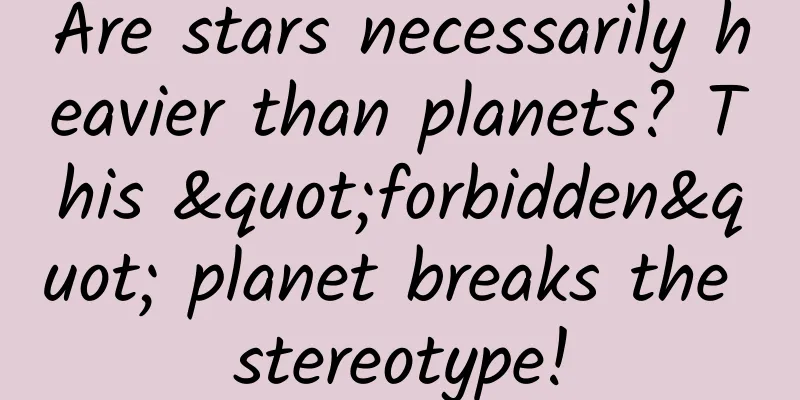Are stars necessarily heavier than planets? This "forbidden" planet breaks the stereotype!

|
This 'forbidden' exoplanet is too massive for its star "This discovery makes us realize how superficial our understanding of the universe is. We would not have expected the existence of such a heavy planet around such a low-mass star." Image of a massive planet orbiting a low-mass star (Image source: Pennsylvania State University) Astronomers have discovered a massive planet outside our solar system, or "exoplanet," orbiting an ultracool dwarf star that is too small to host such a world, challenging scientists' models of how planets and planetary systems are born. The planet, named LHS 3154 b, has a mass 13 times that of Earth, which means it is similar in mass to our solar system's ice giant Neptune, but it orbits tightly around a small dwarf star that is nine times less massive than our sun. This means the mass ratio between this Neptune-like world and its parent star - LHS 3154, located about 51 light-years away - is 100 times that between Earth and the sun, which researchers thought was impossible. This is the first time a planet of this mass has been found around a smaller star in the universe. "This discovery really drives home how little we know about the universe," said study co-author Suvrath Mahadevan, the Verne M. Willaman Professor of Astronomy and Astrophysics at Penn State, in a statement. "We would not have expected a planet this massive to exist around such a low-mass star." Challenging the birth of stars and planets Stars are formed when large clouds of gas and dust accumulate into overdense patches that grow and eventually collapse under their own gravity. In this way, a young star is surrounded by residual material called a "protoplanetary disk." As the name implies, it is from this leftover disk that scientists believe planets eventually form. The amount of material left over from the star formation process sets a limit on the size of these potential planets. The team determined that LHS 3154 b's planetary core is so heavy that the planet-forming disk it came from must have had a lot of solid material. In short, it must have had more material than current models predict, explained Megan Delamer, a graduate student in astronomy at Penn State. The discovery of this particular exoplanet therefore raises questions about star formation, because the dust-to-mass ratio and the dust-to-gas ratio in LHS 3154's initial protoplanetary disk would have had to be 10 times higher than predicted to give rise to a massive Neptune-like world like LHS 3154 b. "The planet-forming disk around the low-mass star LHS 3154 would not be expected to have enough solid mass to form this planet," Mahadevan explained. "But it is there, so now we need to revisit our understanding of how planets and stars form." (Left) Earth-Sun system (Right) Newly discovered exoplanet LHS 3154 b and its star system (Image credit: Pennsylvania State University) Habitable zone planet probe exceeds expectations Mahadevan and his colleagues detected the exoplanet LHS 3154 b using the Habitable Zone Planet Finder (HPF), an astronomical spectrograph on the Hobby-Eberly Telescope at McDonald Observatory in Texas. HPF is designed to detect exoplanets as they orbit some of the coolest stars in the Milky Way. In fact, Mahadevan and a team helped build the instrument, which focuses on planets that are neither too close nor too far from their stars to host liquid water, a key condition for life. These planets are in the so-called habitable zone around their stars. Such planets are not easy to spot, in part because the habitable zones of cool stars are closer to them than our own, meaning that these planets are often blocked by the light from their relatively small parent stars. Additionally, the planets themselves are expected to be small, making them more difficult to detect. "Think of a star as a campfire. The cooler the fire, the closer you need to be to the fire to keep warm," Mahadevan said. "The same is true for planets. If the star is cooler, then the planets need to be closer to the star so that it will be warm enough to host liquid water." "If a planet orbits close enough to its ultracool star, we can detect the planet by observing very subtle changes in the star's spectrum, or the color of its light, as it is tugged by the orbiting planet." - 10 most Earth-like exoplanets - Two potentially habitable Earth-like planets orbit a star in the universe's backyard - Two "super-Earth" exoplanets discovered in the habitable zone of a nearby star "Detecting LHS 3154 b is very important for HPF because it shows the instrument's potential to provide important exoplanet results. This result exceeded all expectations for the instrument," said team member Carolyn Miller, a NASA Sagan Fellow in Astrophysics at Princeton University. "Our discovery provides an extreme test case for all existing theories of planet formation," Mahadevan concluded. "This is exactly what we built HPF to do, to discover how the most common stars in the Milky Way form planets and to find these planets." BY: Robert Lea FY: 33 If there is any infringement of related content, please contact the author to delete it after the work is published. Please obtain authorization for reprinting, and pay attention to maintaining integrity and indicating the source |
<<: What is it like to fall in love with AI? Netizens: It's too addictive!
>>: Ginkgo biloba is an endangered plant, even though it can be found everywhere.
Recommend
How to correctly and completely disassemble an App
We all know that Internet workers, especially tho...
The journey to Middle-earth has come to an end, but female consumption has just begun
The extended version of the third part of "T...
What are the functions of the Guangzhou Auto Mini Program? How much does it cost to develop a WeChat car mini program?
In 2021, China's car ownership will reach 350...
Bizarre: A review of the top 10 retractions in the life sciences in 2021
Since the outbreak of the COVID-19 pandemic, jour...
Thyroid cancer is becoming more and more common. What should you eat after surgery?
The thyroid gland is the largest endocrine organ ...
Is it possible that the speed of light is faster in some places in the universe and slower in other places?
The author or source of this article or its origi...
Why do Android fans choose iPhone 6s instead of Nexus 6P?
Antonio Villas Boas is a technology journalist. A ...
Are humans still evolving? Four generations of mice living together give us inspiration
I always see people saying that in developed coun...
Esquire Bluetooth speaker costs 1530 yuan and has a built-in conference call system
[September 10 news] Recently, Harman Kardon launch...
WeChat and Alipay payment codes are restricted because of this group of people who launder money too aggressively
[[437025]] Early this morning, the message board ...
Pioneer 10: A tour of the planets
Pioneer 10 was the first probe to successfully ac...
A complete event operation plan!
Operations are basically a process of constantly ...
If the earth stopped rotating, where could we survive?
Produced by | Science Popularization China Author...
The establishment of the fourth operator of the State Grid may promote the development of 4K TV
In recent years, there have been more news report...









